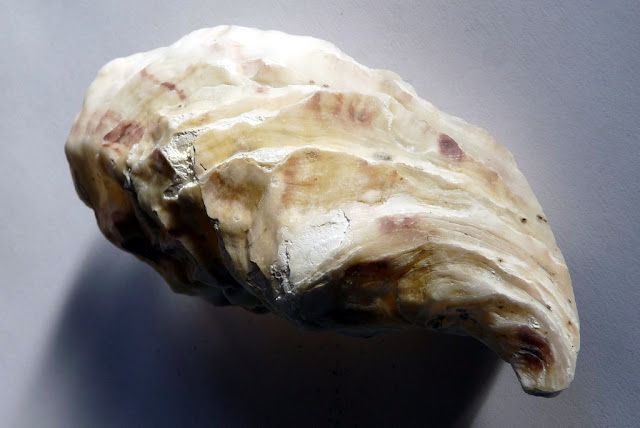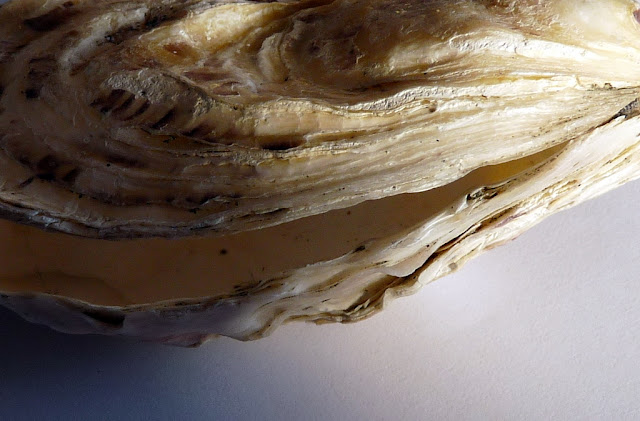Not picking up seashells from the beach is like not eating peanuts when they're put in front of you with a drink, you tell yourself you won't, but you always do. Though I think seashells are nicer than peanuts.
Though I didn't exactly pick the slipper limpet up because it was nice, but because it was stand-out weird. In fact Rouchswalwe supplied a good alternative title for this post in the comments to the last one, a Mary Barnard Sappho translation:
If you are squeamish
don't prod the beach rubble.
The shell had evidently been colonised by perhaps more than one kind of worm and/or parasitic sponge, either during or after its occupant had lived in it, and was perforated and sculpted by excrescences almost beyond recognition. The fragment of mussel shell was originally secreted inside it.
Slipper limpets are rather nasty and not at all personable things anyway. They are an invasive alien species that came to Europe on ships hulls in the last century; they are unattractively coloured and shaped and form rather grotesque masses by piling up on top of each other, and they steal food from oysters and other shellfish. They are also know as fornicating slipper shells, presumably not to their friends. There's another good link here which tells the sorry tale of the oyster and the slipper limpet. (It's quite interesting to try to say 'slipper limpet' over and over very quickly).
I am aware that the above on the character of these gastropod molluscs is lamentably subjective and unscientific, but that's me. However, I do have curiosity about the natural world, to satisfy which my first port of call is always the set of hand guides to which this volume belongs.
They are delightful little books on all kinds of nature-related subjects, this one and the one on butterflies and moths being amongst my most used. Tom bought them for next to nothing in a remainder bookshop about twenty years ago, before I knew him and a very long time before the internet; they are long out of print and were perhaps designed with school libraries in mind, but the painted illustrations, which show whole scenes and habitats, which you can look at for ages, often revealing minute and whimsical details. In the one on wild animals (taxonomically sloppy, including as it does mammals, amphibians and reptiles but not birds, fish, insects etc which are in separate volumes) for example, there is a scene of a river bank where otters and mink are playing and in the distant background, behind a dead tree, a tiny naturalist with binoculars, perhaps two millimetres tall, is watching them.
It's just one aspect of what I think I really like about them, which is the presence of affect, a personal touch, and a sense of wonder. The text is clearly accurate, carefully condensed and written by someone who knows their stuff, but also loves their stuff.
For example in Saltmarsh: Middle Level, Turf
... the sea-pink is the same beautiful plant as lives on the cliffs. All the middle level of the saltmarsh is coloured by it in May and June, followed by sea lavender, blue-purple in high summer. These hazes of colour, picked out by the other flowers, embody the essence of the word 'saltings'.
Scurvy grass is a close relation to watercress, and not a grass at all. Rich in vitamin C it was used to combat scurvy long before becoming an essential medicine on those sailing voyages from the 16th century onwards. The taste is revolting. Crews must have cheered when lime juice replaced it.
This is the page on Rocky Shore: builders and borers in the Sea Coast volume.
Nobody knows how 'serpulid' worms extract molecules of calcium carbonate from seawater and then pass them from glands behind the worms head to be moulded by the worm's collar with mucous into rock-hard tubes, each species with its own shape. Building is mainly in summer. Externally the tubes are variously cemented to the rock. Internally there is no organic union between the body and the tube.
It seems a little sad to me that the work of such evidently gifted and skilled writers, naturalists and artists should be languishing in the pages of relatively humble and forgotten books; I hope they enjoyed themselves anyway, and felt sufficiently appreciated at the time. The information on individual species is necessarily limited by space, but I always prefer to go to a book first if I can, then follow its lead to more information on the internet, so I shall probably try to find out more about the bizarre aliens that made my sculpted shell.
But, as the writer advises in the notes at the back of the book on Things to do', along with such solid advice as have a hardback notebook (nobody can write in a floppy one),
Nothing replaces seeing for oneself... recognise at once the insidious illusion that understanding can spring from just reading books and watching television... Never mind science for a moment, let the beauty sink in...'
Along with the slipper limpet, I also brought back a whole but empty oyster shell. It is not a native but a Portuguese oyster, (by the look of it from the book), a species introduced to strengthen the indigenous stocks which were, I think, affected with disease and the encroachments of invasive creatures like the slipper limpets.





















9 comments:
Edibility's so important. And in that one must be preceded by someone brave. It took great courage even to try something called scurvy grass, given that the name doesn't explain whether it's a source of scurvy or a specific against it. Being able to say "The taste is revolting." deserves a roll on the timpani.
One pleasure about eating oysters is the faux sense of heroism and the enormous feelings of superiority over those who are having to suppress their gagging. I mentioned this anecdote some years ago but let's hope everyone's forgotten. Oysters were on sale in the Super U car-park on Sundays at St Gildas-des-Bois. Mrs LdP and I didn't need to taste but since tasters were freebies we did anyway. The vendor - almost a caricature Breton - nodded to our elder daughter. I explained she'd never tried one and his reaction was to open another. In a slightly louder voice I said "Her first oyster" and immmediately the customers within earshot formed an interested circle. Amazingly, she liked it and I'll swear their interest turned to smugness. Of course she would, they were telling themselves.
Oh, what gorgeous photos, Lucy, even the 'ugly' things are beautiful! and I love this post. It reminds me how very ignorant I still am about much seashore life, and even some of the tastes (I'm ambivalent about oysters). May I blame growing up inland as a freshwater girl? Yet I've lived on the sea coast more than half my life now. I wish I had your delightful little books to take along next time we go to the much wilder edge of the Pacific, on the west coast of Vancouver Island. Come to think of it, it was there, in a nice little restaurant in the village of Tofino that I had the best oysters.
Holy Seafood, Batman!
Nifty keen! So glad you're not squeamish, dear Lucy! I was only able to get through 7 recitations of slipper limpet before it sounded like something a dental patient would say on the first try. Ach, I miss the seafood and the beaches of southern Japan!
Beautiful photographs and observations, Lucy. I too have a copy of that book, and keep it at our beach-side cottage overlooking Cardigan Bay. The series is marvellous, and this one perfect for adults and children alike.
What you say about picking up beach stuff is so true. I managed to come home from New Zealand this time with only a handful, but that's because I have many bowls filled with past years' collections. What you say about the limpets makes me think of how I feel about starlings at my bird feeders. Ugh! Amazing photos.
'never mind science for a moment... let the beauty sink in' could easily become a catch-phrase, I feel.
Slipper limpet slipper limpet slipper limpet slipper limpet slipper limpet
I love the squiggly innards in those photos, and the porous exteriors.
Also the illustrations in the book. I had similar books as a kid, so looking at this one is bringing on some nostalgia.
Thank you Lucy, I always learn something useful from you.
I had a series of books that were about a year in the life of a fox, a hedgehog, a robin etc etc and lots of Usborne books.
I managed just six recitations. The seventh was slimmer limit.
Post a Comment